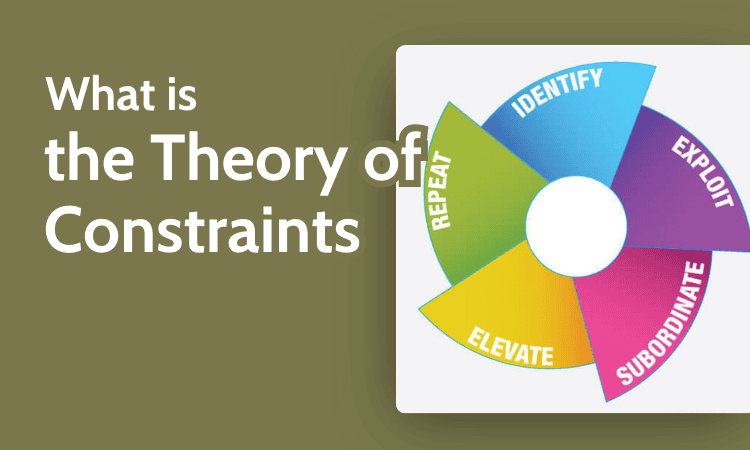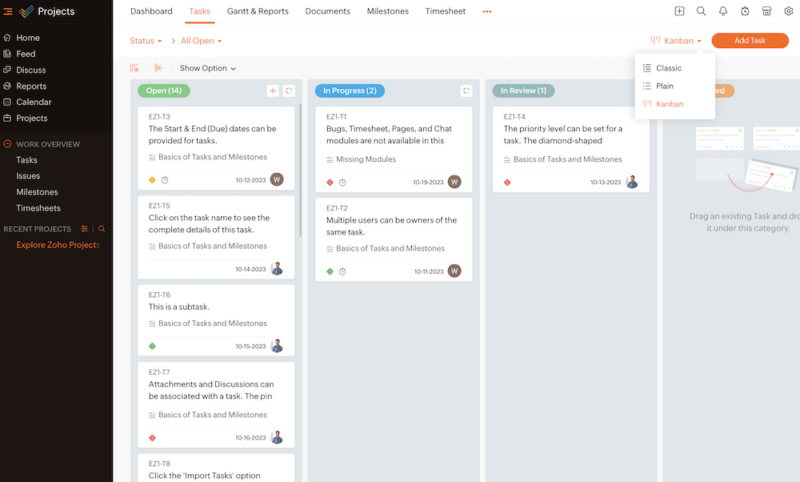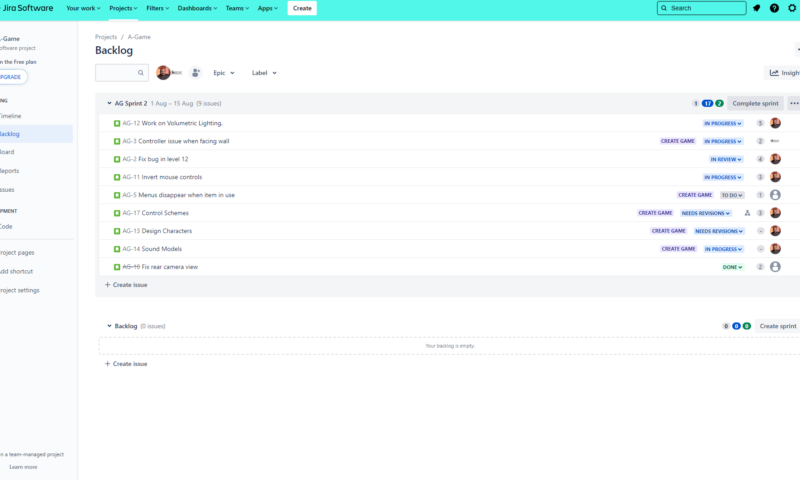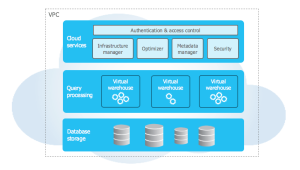
Why you can trust us
- 407 Cloud Software Products and Services Tested
- 3056 Annual Software Speed Tests
- 2400 plus Hours Usability Testing
Our team of experts thoroughly test each service, evaluating it for features, usability, security, value for money and more. Learn more about how we conduct our testing.
Key Takeaways: What Is the Theory of Constraints?
- The Theory of Constraints (TOC) is a method for helping managers identify and fix constraints in production lines or project management processes.
- While TOC is commonly associated with Critical Chain Project Management, it can be used with Agile frameworks and other traditional project management methods like Waterfall.
- The primary goal of TOC is to ensure the highest possible throughput of tasks in projects or items on a production line.
Facts & Expert Analysis: Theory of Constraints
- TOC origins: Eli Goldratt developed the Theory of Constraints in 1984 and covered it in great detail in his book “The Goal: A Process of Ongoing Improvement.”
- Lean and TOC: Many confuse the Lean and TOC methods. While they both aim to improve customer satisfaction, Lean does so by eliminating waste and reducing costs, while TOC focuses on increasing throughput.
- Decision trees and DBR: The Theory of Constraints uses two concepts to ensure high throughput. The Drum-Buffer-Rope method creates consistency in schedules, and decision trees help managers identify constraints.
Every project manager will encounter problems during the lifecycle of a project. However, even with the best project management software, identifying and removing bottlenecks before they have an impact is easier said than done. Don’t lose hope, though, as the Theory of Constraints (TOC) can help you identify weak links to improve systems and team efficiency.
In this article, we’ll explain what TOC is and cover the five critical steps that make it work. We’ll also examine the Drum-Buffer-Rope method (a planning concept) and explore how it functions. Our experts will also list some of the constraints that project teams can expect to encounter. We know you’re eager to learn, so let’s jump into this project management guide.
Meet the experts
Learn more about our editorial team and our research process.
Definition: What Is the Theory of Constraints?
Created by Eli Goldratt in 1984 and discussed in his book “The Goal: A Process of Ongoing Improvement,” the Theory of Constraints helps organizations identify and remove constraints (a limiting factor or weak link) from processes and systems. While often associated with Critical Chain Project Management, TOC can be used with many project management methodologies.

Identifying and eliminating weak links can be challenging, even when using Gantt charts.
The theory has five steps, which we’ll cover in more detail later: Identify the constraint, exploit the constraint, subordinate everything else, elevate the constraint, then avoid inertia and repeat. TOC states that there’s always at least one system constraint in every project or business process, and that constraints should be used as leverage in continuous improvement efforts.
Project Management
Check out our project management courses and grab a limited-time offer.
Registration available now!
Enroll Now
Using TOC to identify and eliminate system constraints can help improve organizational performance and company profits by increasing throughput. TOC is mainly used by those in manufacturing industries, but it can also be used by project teams in healthcare, HR, software development, marketing and many other industries.
What Are the 5 Focusing Steps of TOC?
The Theory of Constraints is built upon five steps that can help senior managers and project leaders identify and fix the weakest link in each process. Remember that a constraint in project management is anything that might limit the project, such as a resource-intensive step, a procedural bottleneck, or an unexplained delay or expenditure.
Identify the Constraint
The first step is to identify the constraint. Task-tracking tools like kanban boards can help you identify where a bottleneck may exist, as you can easily see which stage of the process is backed up. Time-tracking tools can also help you identify tasks that take the longest to complete. Once you have identified the constraints, it’s time to investigate the project process.

Kanban boards offer a global project view, which makes it easier
to see where tasks are being delayed.
Exploit the Constraint
Now that you understand the issue, it’s time to exploit the constraint and find the root causes. Essentially, you need to deconstruct the process causing the delay to see if it can be improved. You might find that employees need more training, they’re using inadequate tools, or there’s simply too much work for the people covering this process.
Subordinate Everything Else
During this step, determine if other processes (non-constraints) that occur before the weak link are causing the constraint. If so, you may need to adjust these processes so that the entire process works in harmony.
The Drum-Buffer-Rope (DBR) method — which sets a drum beat or rhythm for the entire system from the constraint — comes into play here. We will cover the DBR method in more detail later. As a rule, though, you should always try to fix the constraint at its source before changing the production rhythm to accommodate it.
Elevate the Constraint
By step four, you should have a firm grasp of the constraint. Now, you must determine how to fix the problem. It could be time to hire more employees, invest in training or purchase new tools to help your team overcome the issues they are facing.
Prevent Inertia and Repeat
Bravo! You have fixed the constraint, but don’t think your work is done. The Theory of Constraints is a system that champions continuous improvement, so the process of improving systems never stops.
Once you fix a constraint, a new one will likely emerge. You need to do your due diligence and constantly watch over your processes to ensure that everything works to the beat of the drum. If not, start at step one and repeat the process to identify and fix the problem. You want to avoid inertia (standing still and becoming complacent) by constantly moving forward.
Function: How Does the Theory of Constraints Work?
The Theory of Constraints can become incredibly complex, so we will do our best to keep our explanations simple. TOC aims to help project leaders identify and eliminate the biggest limiting factor in a process or system. To help you visualize TOC in action, we’ll create a simple example of the process.
Example of the Theory of Constraints in Action
Let’s imagine we produce televisions. Processes like parts sorting, component installation and final assembly are working flawlessly; however, we’ve found a bottleneck in the quality control department. The TVs that require testing are backed up, and departments like packing and shipping are experiencing downtime, which is negatively impacting operating expenses.
If we follow the TOC steps to work on this issue, the process would look like this:
- Identify the constraint: TVs on the production line are being held up by the quality control department, which is slowing down the packing and shipping departments.
- Exploit the constraint: After reviewing the quality control process, we discovered that we only have two TV panel calibration tools for five testers and that two quality control technicians are unfamiliar with testing methods.
- Subordinate everything else: After review, we found no issues in the processes that occur before the TVs reach the quality control department. We can either alter the rhythm of the drum to slow production and stop the TVs from backing up, or we can fix the constraint.
- Elevate the constraint: To fix the constraint, we purchased three more tools to check the TV panels and retrained the two techs on testing procedures.
- Avoid inertia and repeat: We fixed the constraint, which increased throughput (the number of TVs coming off the production line), which positively impacted company profits. We then looked for the next constraint and improved those processes.
What’s the Goal of the Theory of Constraints?
The overarching goal of the Theory of Constraints is to remove weak links that can slow your company or project team’s throughput. You might be wondering what throughput is, so let’s clear that up.
Throughput is a term often used when discussing money or company profits. This is known as throughput accounting. In project management, throughput refers to the amount of work your team can complete. For example, this can be the number of features a software development team can create during a sprint using the Scrum framework.
Teams using Agile frameworks or traditional methodologies, like PRINCE2 and Waterfall, can use the Theory of Constraints to help them improve team productivity and throughput.
Theory of Constraints Thinking Processes
It can be easy to get lost in the weeds when talking about the Theory of Constraints, as it’s a very complex subject. While we have kept the guide high-level so far, we do need to discuss some processes that can help project managers discover and fix constraints.

Mind maps, like those found in ClickUp, can help you create decision trees.
If you’re managing a project and you know there’s a constraint but just can’t put your finger on it, you can use decision trees (a discovery method) to help you analyze processes and systems. Decision trees are mind maps that let you create models that map out constraints, decisions and potential outcomes.
There are four decision trees that project managers can use: the current reality tree (CRT), the evaporating cloud tree (ECT), the future reality tree (FRT), and the strategy and tactics tree (STT). The handy table below explains how each decision tree is used.
| Tool | Role | Description |
|---|---|---|
| Current Reality Tree | Maps out the current state of processes and constraints | The CRT maps out underperforming processes. The tree helps managers identify problems and understand their root causes. |
| Evaporating Cloud Tree | Identifies constraints with no clear solution | The ECT helps identify changes that could solve constraints. |
| Future Reality Tree | Documents what future processes should look like | The FRT maps out what critical chain processes could look like when ideas from the evaporating cloud tree are implemented. |
| Strategy & Tactics Tree | Maps out a plan of action | The STT maps out steps that should be taken to implement changes, remove constraints and improve processes. |
Theory of Constraints Measures
Project managers using the Theory of Constraints can utilize three measures to track progress, improvements and project success. While these are more commonly used in the throughput accounting side of things, they can also be used to measure project success. The three measures are as follows:
- Throughput: In accounting, this characteristic measures the profit generated by sales; in project management, it relates to the work your team completes.
- Operating expenses: Accountants in manufacturing industries use this measure to determine how much money has been generated by turning inventory into throughput (products). Project managers can use it to assess project expenses after paying for resources like equipment and wages.
- Inventory: This measure is used to determine how much money has been spent on required resources, like facilities, equipment, raw materials and consumables, for the production run or the project’s lifecycle.
What Is the Drum-Buffer-Rope Method?
The Drum-Buffer-Rope (DBR) method can help schedule and manage processes with constraints. The method states that a system’s output can only be as great as the tightest constraint allows, and that any attempt to push past the constraint will cause a backup of products or tasks.
Each part of the method (drum, buffer and rope) relates to a different part of an organization’s process. Below, we’ll explore the three parts of this method.
The Drum
The drum is the rate at which the team can work based on current constraints. When a constraint is reached, the rest of the team can only work as fast as the beat of the constraint.
The Buffer
The buffer in TOC protects the flow of work and ensures that project tasks or production lines stay on track. To protect your workflow, the constraint buffer adds 50% more time over the projected completion time, while the customer buffer — placed at the end of a project or production schedule — protects shipping schedules or project completion dates.
The Rope
In TOC, the rope signals that the inventory consumed during the process must be replenished. The first signal triggers a secondary signal that calls for more inventory to be released to continue production. The rope’s role is to ensure that inventory isn’t stagnant and that throughput is consistent.
Example of Drum-Buffer-Rope
Thinking back to our television production scenario, if only two TVs pass quality control every 10 minutes instead of the required 10 units, packing and shipping can also only process two units every 10 minutes. Our constraint is causing an obvious slowdown and is affecting the beat of the drum (throughput) past the quality control department.
We can approach this issue in two ways: We can slow production so that two TVs arrive at quality control every 10 minutes, or we can fix the constraint so that the rest of the line can match the tempo set by the earlier production stages. We’ll fix the constraint by working the five stages of TOC to restore the drum beat (the required throughput of 60 units per hour).

The Critical Chain Project Management methodology uses buffers
to protect project completion dates.
At this point, we know the constraint is preventing us from meeting our throughput goal, which means we’ll miss our deadline. However, thanks to DBR, we have project buffers. The built-in buffers add extra time to the production process. Essentially, we have an extended deadline that gives us time to fix the constraint.
For projects using Critical Chain Project Management, managers set a completion date 50% later than needed. For example, you may know a project can be completed in 30 days, but you set the due date 45 days out. This way, if issues arise that cause you to miss the internal 30-day goal and it takes 45 days to complete, the client still thinks the project was delivered on time.
The rope in DBR is a parameter that monitors and controls inventory flow. In our TV production scenario, the goal is to assemble 60 TVs per hour, so enough components must be released to make 60 units per hour. Once 60 units have been assembled, more inventory is released to repeat the cycle. This eliminates the chance of inventory being damaged when it isn’t needed.

In the DBR method, the rope determines how much inventory or how many tasks are released from the backlog to workers. The idea is to create continuous throughput but not overwhelm.
In project management, we can look at backlogs to explain the rope. The rope would control the release of tasks from the product backlog. If your team’s velocity is high enough to complete 10 features in a two-week sprint, the rope won’t allow more than 10 tasks to leave the backlog during the sprint because doing so would overwhelm developers and cause a drop in quality.
After a sprint is complete and a sprint review has been held, the product owner issues developers 10 more features to complete during the next two-week sprint.
Types of Constraints in Project Management
The Theory of Constraints examples below will help you better understand what you could encounter during a production run or project.
| Type of Constraint | Description |
|---|---|
| Time Constraints | These are constraints related to the amount of time it takes to complete a task. |
| Scope Constraints | Project managers can encounter scope creep if constraints like resource budgets for employees aren’t met. |
| Simple Constraints | Simple constraints are easy to fix but could lead to issues if overlooked. For example, a production line could stop because all staff members take breaks simultaneously. |
| Market Constraints | These are any events outside your control that can significantly impact sales and your company’s bottom line. Examples include reduced demand or increased raw material costs. |
Benefits & Importance of the Theory of Constraints
There are benefits to adopting the Theory of Constraints. While it may take a while for you or a change manager to implement this way of working, you’ll soon benefit from the following:
- Increased efficiency: Eliminating constraints will make project teams and production lines more efficient. Tasks will be completed quicker, products can be made faster, and deliverables will be in the clients’ hands sooner.
- Enhanced profits: Improving systems and processes can directly impact your bottom line by increasing throughput, and by cutting production and labor costs.
- Continual improvement: Having a mindset of continual improvement will benefit your organization or project team. By focusing on improvement, money invested will go further, employees will grow, and throughput will increase.
- Increased risk mitigation: Using decision trees to identify current constraints and map out plans to improve performance can help reduce the risks and issues you face during production runs and project lifecycles.
How Is the Theory of Constraints Connected to Lean Manufacturing?
While Lean principles and the Theory of Constraints both help enhance project management processes and production lines, they are different approaches. TOC focuses on identifying and removing constraints to increase throughput and improve profitability, while Lean methods focus on eliminating waste to reduce costs.
However, both methods aim to improve customer satisfaction and make teams more efficient, and they can be used concurrently. The table below covers the biggest differences between the two.
| Areas of Focus | Lean Thinking | Theory of Constraints |
|---|---|---|
| Scheduling | Clients and stakeholders set project deadlines | The constraints in current systems and processes determine the pace and schedule |
| Inventory Management | Uses the Just-in-Time inventory management method to ensure just enough inventory is on hand to meet demand | Plenty of inventory is kept on hand to ensure throughput is maintained |
| End Goal | Reduce waste and manufacturing costs | Ensure production lines and project teams work at maximum capacity |
| Work Methods | Uses stream mapping to create end-to-end production processes | Uses the Drum-Buffer-Rope method to drive pace, throughput and scheduling |
The method that’s suitable for you depends on the demands of your company or customer. If extreme efficiency, waste reduction and a reduction in variable outcomes via Six Sigma is in order, Lean methods are for you. If cranking out tasks and products at high rates via the DBR approach is in the cards instead, choose TOC.
It’s also worth noting that you can combine TOC, Six Sigma and Lean methods to create production lines that deliver high throughput rates while reducing production errors and waste.
Final Thoughts
The Theory of Constraints is a method that managers use to identify and fix constraints that harm their team’s output. The benefits of this method are clear: increased efficiency, better risk mitigation, increased profits and higher throughput. If you’re looking for ways to improve processes and increase team output, TOC is a method you should examine further.
Have you used the Theory of Constraints to help identify areas of opportunity? Has the method helped you eliminate the undesirable effects of constraints? Did you choose Lean over TOC? If so, why? Let us know in the comments. Thanks for reading.
FAQ: Constraints Theory
-
The Theory of Constraints is a method for identifying and fixing project constraints so that maximum throughput can be achieved.
-
The five steps of the Theory of Constraints are as follows: Identify the constraint, exploit the constraint, subordinate everything else, elevate the constraint, and avoid inertia and repeat.
-
The three principles of the Theory of Constraints are convergence, consistency and respect.
The Theory of Constraints is a method for identifying and fixing project constraints so that maximum throughput can be achieved.n”}},{“@type”:”Question”,”name”:”What Are the 5 Steps of the Theory of Constraints?”,”acceptedAnswer”:{“@type”:”Answer”,”text”:”
The five steps of the Theory of Constraints are as follows: Identify the constraint, exploit the constraint, subordinate everything else, elevate the constraint, and avoid inertia and repeat.n”}},{“@type”:”Question”,”name”:”What Are the Principles of the Theory of Constraints?”,”acceptedAnswer”:{“@type”:”Answer”,”text”:”
The three principles of the Theory of Constraints are convergence, consistency and respect.n”}}]}]]>
Let us know if you liked the post. That’s the only way we can improve.


